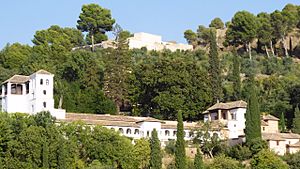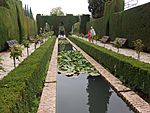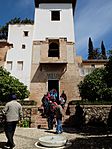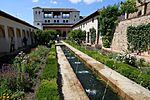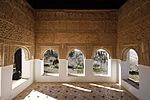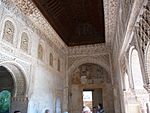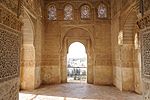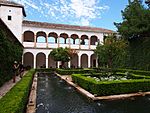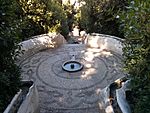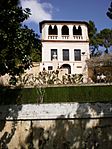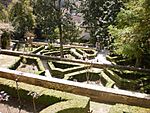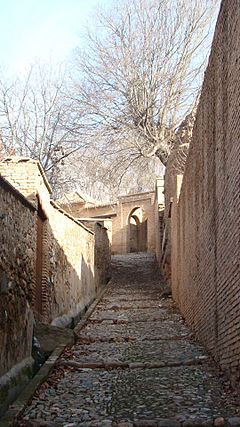Generalife facts for kids
Quick facts for kids Generalife |
|
|---|---|
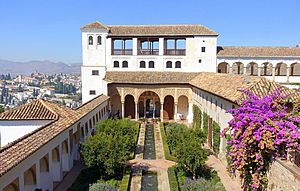
The Patio de la Acequia
|
|
| Location | Granada, Andalucía, Spain |
| Built | 14th century |
| Governing body | Ministry of Culture |
| Official name: Alhambra, Generalife and Albayzín, Granada | |
| Type | Cultural |
| Criteria | i, iii, iv |
| Designated | 1984 (8th session) 1994 (18th session – Extension) |
| Reference no. | 314 |
| Region | Europe |
The Generalife is a beautiful summer palace and country estate. It was built for the Nasrid rulers, who were kings of the Emirate of Granada in a region of Spain called Al-Andalus long ago. This amazing place is in Granada, Spain. It sits on a hill, just east of the famous Alhambra palace. The Generalife was a special place where the rulers could relax and enjoy nature.
What's in a Name?
The name "Generalife" comes from an Arabic phrase, jannat al-‘arīf. This phrase can mean a few different things. Some people think it means "Garden of the Architect" or "Garden of the Artist." Others suggest it could mean "Garden of the Gnostic" or even "Garden of the Flautist."
However, some experts believe the real meaning might be simpler. It could have originally meant "Principal Orchard." An old inscription inside the palace calls it the Dar al-Mamlakat as-Sa'ida, which means "House of the Felicitous Kingdom."
History of the Generalife
Early Days: Nasrid Rulers
During the time of the Nasrid rulers, the Generalife was known as an almunia. This was a country villa used for two main purposes. It was a private getaway for important people. It also served as a working farm with fields for growing crops.
Building these country estates and gardens was a tradition in Al-Andalus. It started way back in the 8th to 10th centuries. Similar gardens can still be seen in places like the Agdal Gardens in Marrakesh, North Africa.
The Generalife was likely built by Muhammad II around the late 1200s. Or perhaps it was started by Muhammad III in the early 1300s. Muhammad III definitely added the mirador (a special lookout room) to the palace.
Later Nasrid rulers also worked on the Generalife. Isma'il I remodeled and redecorated it in 1319. Muhammad V, who built a lot in the Alhambra, also made changes here. Finally, Yusuf III updated the southern parts of the palace in the 1400s.
After the Reconquista
After the Christian rulers took over Granada, the Generalife changed quite a bit. This happened from the 1500s all the way to the 1900s. The Catholic Monarchs added an upper floor to the northern part of the Patio de la Acequia in 1494. The nearby Patio de la Sultana was completely redesigned in the 1500s.
A traveler from Venice, Andrea Navagero, visited in the 1520s. His descriptions helped experts understand what the palace and gardens looked like originally.
In the 1900s, the gardens got their current look. Leopoldo Torres Balbás and Francisco Prieto Moreno redesigned much of it. They worked on it between 1931 and 1951. They added some Italian style to the design.
In 1958, a big fire damaged parts of the Generalife. But this fire also helped archaeologists. They were able to dig and find out how the original gardens looked. For example, they found the old paved paths and the original soil of the Moorish gardens. They also found holes that helped water the gardens.
Since 1984, the Generalife has been a UNESCO World Heritage Site. It shares this special status with the Alhambra.
What You See Today
Today, the Generalife is a mix of old Nasrid parts and newer additions. This is especially true for the gardens. The walkways are paved in a traditional style. They use white pebbles from the River Darro and black pebbles from the River Genil.
The Outer Gardens
The Generalife gardens are spread across three large terraces on the hillside. Each terrace is about 35 meters (115 feet) wide and 250 meters (820 feet) long. The two lower terraces are used for market gardens and orchards. These are called Las Huertas today. They have been used for farming since the 1300s.
The highest terrace has the Jardines Nuevos, or "New Gardens." These gardens were created in the 1900s. They are the main way visitors enter the historic palace today. The southern part of these gardens was finished in 1951. It has walls made of trimmed cypress trees. There is also a large cross-shaped pool, inspired by old Islamic gardens. An open-air theater was added here in 1952. The northern part of the gardens has a rose bush maze. It was designed in 1931.
The Main Palace
The Generalife Palace itself is on a fourth terrace, above the outer gardens. The heart of the palace is the Patio de la Acequia, or "Courtyard of the Water Canal." This is the largest part of the palace. It is about four times longer than it is wide. You enter it through smaller courtyards. The word acequia comes from an Arabic word meaning "water canal."
The courtyard has a long garden divided into four equal flowerbeds. This type of garden, with a four-part division, comes from ancient Persian gardens. A water channel runs down the middle of the courtyard. Water jets on either side spray water across the pool. There are also two fountains at the ends of the channel. A small lookout room, or mirador, sticks out from the western wall. This room has beautiful carved stucco decorations. It is one of the oldest miradors in this type of architecture.
The Patio de la Acequia has pavilion-like buildings at its north and south ends. The Pabellón Sur (South Pavilion) has two floors. The north pavilion was once called the "Main Hall" or "Fortunate Hall." It has a portico with five arches. These arches are decorated with beautiful carved stucco and Arabic writing. Behind the arches is a covered gallery. This leads to another room called the Salón Regio (Royal Chamber). This room also has amazing stucco decorations and a wooden ceiling. A tower on the north side of this room has another mirador. This lookout offers great views of the Albaicín neighborhood.
Just above the Patio de la Acequia is the Patio de la Sultana, or "Courtyard of the Sultana." This courtyard has pools, gardens, and paved paths. Its current design is from after the Nasrid period.
The Water Stairway and Upper Gardens
Above the Patio de la Sultana is the famous Water Stairway, or Escalera del Agua. This staircase has four sections. Along the sides of the stairs, water flows in channels carved into the railings. Small circular terraces with fountains break up the stairway. At the top is a small pavilion from the 1800s, called the Romantic Pavilion.
Next to the stairway are the High Gardens, or Jardines Altos. These gardens are arranged on several terraces going up the hillside. The Paseo de las Adelfas (Walk of the Oleanders) is at the southeast end of the gardens. This is the path visitors use to exit the Generalife today.
How it Looked Long Ago
Original Layout and Use
The Generalife palace and gardens were a private getaway for the Nasrid rulers. It was their summer home, away from the busy official life at the Alhambra. The entire area was once surrounded by a long wall, which is no longer there.
A big part of the Generalife's gardens was used for farming. They grew crops, had orchards, and even pastures for horses. Two other palaces were also built nearby on the same hillside. These were the Alijares Palace and the Dar al-'Arusa. Not much of them remains today. The Silla del Moro, a ruined structure on the hilltop, was once a fort. It protected the water supply for this area.
While there was a main entrance for visitors, the Nasrid rulers had a secret way to get to the Generalife. They used a private, hidden passage that went between the Alhambra and the Generalife. This passage still mostly exists today. It started at the Torre de los Picos in the Alhambra. It crossed orchards and gardens. Then it reached the Generalife Palace through some fortified towers. This gave them direct entry into what is now the Patio de Polo.
The Palace Complex in Nasrid Times
The Patio de la Acequia, the Patio de la Sultana, and the Water Stairway all existed during the Nasrid period. However, the Patio de la Sultana has been completely rebuilt since then. The Patio de la Acequia still has many original parts. Its gardens are modern, but they follow the original design. This includes the four-part division and the central water channel.
The southern building of the courtyard, the Pabellón Sur, was changed the most. It was originally part of the ruler's home. The southwestern wall of the gardens used to be much taller. It had no windows, making the garden very private. Today, it's an open gallery with windows looking out to the Alhambra. A small piece of the original decorated wall still remains. The mirador (lookout pavilion) in the middle of the wall did exist originally. It had low windows for views outside.
The northern pavilion, which has the Salón Regio, has more of its original features. The tower on its north side, with another mirador room, was added in 1319. However, the open gallery on the upper story was added by the Catholic Monarchs in 1494.
The Generalife had everything a private palace needed. This included a bathhouse and a prayer room. Remains of these were found after the 1958 fire. The bathhouse was likely near the Patio de la Sultana. The prayer room was probably where the Romantic Pavilion stands today.
The original gardens were very different from today's gardens. Today's gardens show Spanish styles from the 1800s and 1900s. Thanks to old descriptions and excavations, we know about the original gardens. In the Patio de la Acequia, the flower beds were lower than the walkways. They likely had low plants like myrtle bushes. Some deeper spots allowed for larger plants like orange trees. The fountains were also different. The lines of water jets in the Patio de la Acequia were added in the 1800s. However, some jet fountains were probably there originally. One old description talks about a fountain that shot water ten yards into the air!
Water Supply System
Water came to the Generalife from the Acequia Real, or "Royal Canal." This canal also supplied water to the Alhambra. It still exists today. It gets water from the Darro River, high up in the Sierra Nevada mountains. This is about 6.1 kilometers (3.8 miles) east of the Alhambra.
A smaller branch, the Acequia del Tercio, split off upstream. It went along higher ground to the Generalife. This supplied water to the upper gardens, the Water Stairway, and the old bathhouse. The main branch went along lower ground. It supplied water to the Patio de la Acequia. These canals often ran on the surface. But some parts went through tunnels cut into the rock. This complex system of channels, tanks, and water wheels supplied water to all the gardens.
One part of this system is the Albercones. This is a medieval water tank that could hold 400 cubic meters (about 105,000 gallons) of water. It helped water the higher orchards and gardens. It is located on the hillside above the Jardines Nuevos today. Two newer reservoirs were added next to it in the 1900s. The old reservoir got water from a deep well. This well was once covered by a tower. Inside the tower, an animal-powered water wheel pulled water from the well. This well connected to an underground channel. This channel drew water from both the Acequia Real and the higher Acequia del Tercio. Both canals continue past the Albercones. They then join and turn back towards the Alhambra. The water enters the Alhambra through an aqueduct.
Cultural Influence
There is a copy of part of the Generalife at Roundhay Park in Leeds, UK.
See also
 In Spanish: Generalife para niños
In Spanish: Generalife para niños
- Buhaira Gardens
- Palacio de Galiana, Toledo
- Spanish gardens



